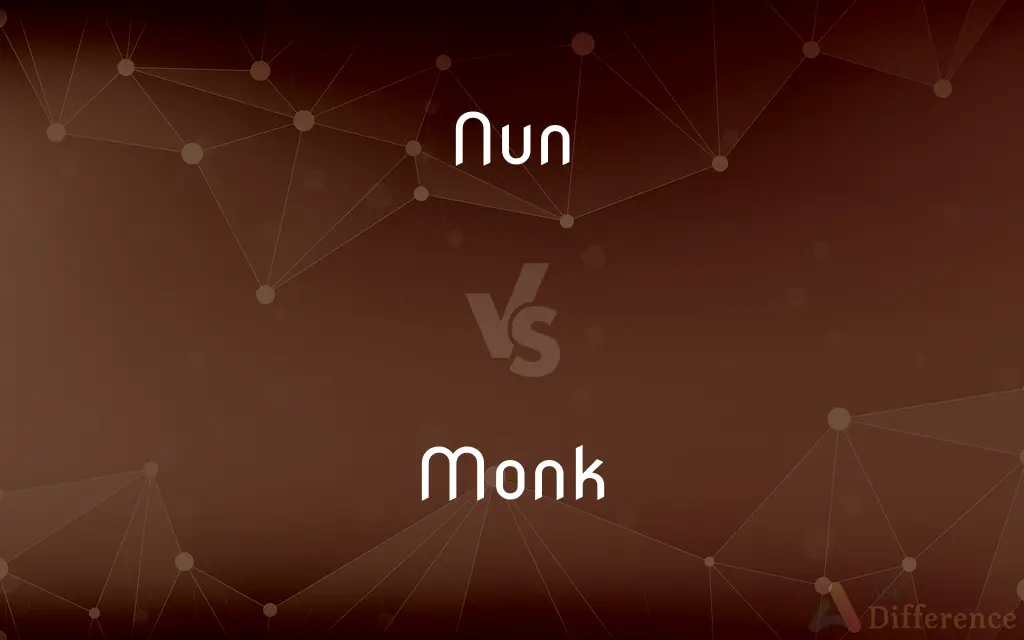Nun vs. Monk — What's the Difference?
Edited by Tayyaba Rehman — By Maham Liaqat — Updated on April 8, 2024
Nuns dedicate their lives to religious service within a female-only community, often embracing vows of poverty, chastity, & obedience, while monks typically live in male-only monasteries, following similar vows but within their gender-specific traditions.

Difference Between Nun and Monk
Table of Contents
ADVERTISEMENT
Key Differences
Nuns are women who commit themselves to a religious life, often living in convents under vows such as poverty, chastity, and obedience. They may engage in various forms of service like education or healthcare, reflecting their order's charism. Whereas, monks are men who live in monasteries and may follow the Benedictine rule of "Ora et Labora" (pray and work), dedicating their lives to worship, meditation, and community service. While both seek spiritual growth and community life, their practices and daily routines reflect their distinct traditions and gender-specific roles.
Nuns participate in the liturgy of the hours, community prayers, and often in ministries related to their order's mission, such as teaching or nursing. On the other hand, monks might focus on manual labor, contemplative prayer, and the production of goods like cheese or beer, contributing to their monastery's self-sufficiency and outreach.
The attire of nuns and monks symbolizes their commitment and varies between orders. Nuns might wear habits with veils, signifying their consecration to God and separation from worldly concerns. Monks' attire, such as the cassock or robe, often reflects their order's history and spiritual focus, serving a similar symbolic purpose.
While both nuns and monks take vows of poverty, chastity, and obedience, the interpretation and expression of these vows can differ significantly. Nuns often engage in external apostolates, directly serving the community's needs, whereas monks might prioritize a life of contemplation, with less direct engagement with the external community.
Nuns and monks both contribute to the spiritual and often social welfare of their communities, yet their paths to serving and living out their vows are molded by their distinct traditions and gender roles. This reflects the diverse ways in which religious commitment can be expressed and lived out within the Christian faith.
ADVERTISEMENT
Comparison Chart
Gender
Female
Male
Community
Convent
Monastery
Typical Activities
Prayer, community service, education, healthcare
Manual labor, contemplative prayer, crafting, farming
Attire
Habit with veil
Cassock, robe, or other traditional monk attire
Focus
Often engage more directly in community service
More inclined towards contemplation and manual work
Vows
Poverty, chastity, obedience
Poverty, chastity, obedience
Rule of Life
Follows specific orders (e.g., Benedictine, Franciscan)
Typically follows the Rule of Saint Benedict or others
Compare with Definitions
Nun
Engages in prayer, meditation, and service.
Every morning, the nun participates in the liturgy of the hours before starting her day.
Monk
Engages in manual labor and crafts as part of monastic life.
The monk is skilled in bookbinding, a craft that supports the monastery's library.
Nun
Lives in a convent or monastery.
The nuns at the convent grow their own food and live a life of prayer and simplicity.
Monk
A man who lives a life of prayer and solitude in a monastery.
The monk spends several hours each day in silent meditation.
Nun
Member of a female religious order.
She became a nun and joined a convent renowned for its commitment to healthcare.
Monk
Member of a male religious community.
He became a monk to dedicate his life to spiritual pursuits and community service.
Nun
Wears specific religious attire as a sign of commitment.
The nun wore her habit and veil as symbols of her vows and dedication to God.
Monk
Wears a cassock or other specific attire denoting religious dedication.
The monk's robe is a symbol of his renunciation of worldly values in favor of spiritual growth.
Nun
A woman who has taken vows of poverty, chastity, and obedience within a religious community.
The nun devoted her life to teaching children in underprivileged communities.
Monk
Follows a specific rule of life, like the Rule of Saint Benedict.
The monks at the monastery adhere strictly to the Rule of Saint Benedict, balancing prayer and work.
Nun
A nun is a member of a religious community of women, typically living under vows of poverty, chastity, and obedience in the enclosure of a monastery. Communities of nuns exist in numerous religious traditions, including Buddhism, Christianity, Jainism, and Taoism.
Monk
A monk (, from Greek: μοναχός, monachos, "single, solitary" via Latin monachus) is a person who practices religious asceticism by monastic living, either alone or with any number of other monks. A monk may be a person who decides to dedicate his life to serving all other living beings, or to be an ascetic who voluntarily chooses to leave mainstream society and live his or her life in prayer and contemplation.
Nun
A member of a religious community of women, typically one living under vows of poverty, chastity, and obedience.
Monk
A man who is a member of a brotherhood living in a monastery and devoted to a discipline prescribed by his order
A Carthusian monk.
A Buddhist monk.
Nun
Any of a number of birds whose plumage resembles a nun's habit, especially an Asian mannikin.
Monk
A male member of a monastic order who has devoted his life for religious service.
Nun
A woman who belongs to a religious order or congregation devoted to active service or meditation, typically living under vows of poverty, chastity, and obedience.
Monk
In earlier usage, an eremite or hermit devoted to solitude, as opposed to a cenobite, who lived communally.
Nun
The 14th letter of the Hebrew alphabet. See Table at alphabet.
Monk
(slang) A male who leads an isolated life; a loner, a hermit.
Nun
A member of a Christian religious community of women who live by certain vows and usually wear a habit, those living together in a cloister.
Monk
(slang) A judge.
Nun
(by extension) A member of a similar female community in other confessions.
A Buddhist nun
Monk
(printing) A blotch or spot of ink on a printed page, caused by the ink not being properly distributed; distinguished from a friar, or white spot caused by a deficiency of ink.
Nun
A prostitute.
Monk
A piece of tinder made of agaric, used in firing the powder hose or train of a mine.
Nun
A kind of pigeon with the feathers on its head like the hood of a nun.
Monk
A South American monkey (Pithecia monachus); also applied to other species, as Cebus xanthosternos.
Nun
The fourteenth letter of many Semitic alphabets/abjads (Phoenician, Aramaic, Hebrew, Syriac, Arabic and others).
Monk
The bullfinch, common bullfinch, European bullfinch, or Eurasian bullfinch (Pyrrhula pyrrhula).
Nun
A woman devoted to a religious life, who lives in a convent, under the three vows of poverty, chastity, and obedience.
They holy time is quiet as a nunBreathless with adoration.
Monk
The monkfish.
Nun
A white variety of domestic pigeons having a veil of feathers covering the head.
Monk
(historical) A fuse for firing mines.
Nun
The 14th letter of the Hebrew alphabet, corresponding in pronunciation to n.
Monk
(colloquial) A monkey.
Nun
The 25th letter of the Arabic alphabet, corresponding in pronunciation to n.
Monk
To be a monk.
Nun
A woman religious
Monk
To act like a monk; especially to be contemplative.
Nun
A buoy resembling a cone
Monk
To monkey or meddle; to behave in a manner that is not systematic.
Nun
The 14th letter of the Hebrew alphabet
Monk
To be intoxicated or confused.
Monk
To be attached in a way that sticks out.
Monk
A man who retires from the ordinary temporal concerns of the world, and devotes himself to religion; one of a religious community of men inhabiting a monastery, and bound by vows to a life of chastity, obedience, and poverty.
Monks in some respects agree with regulars, as in the substantial vows of religion; but in other respects monks and regulars differ; for that regulars, vows excepted, are not tied up to so strict a rule of life as monks are.
Monk
A blotch or spot of ink on a printed page, caused by the ink not being properly distributed. It is distinguished from a friar, or white spot caused by a deficiency of ink.
Monk
A piece of tinder made of agaric, used in firing the powder hose or train of a mine.
Monk
A South American monkey (Pithecia monachus); also applied to other species, as Cebus xanthocephalus.
Monk
A male religious living in a cloister and devoting himself to contemplation and prayer and work
Monk
United States jazz pianist who was one of the founders of the bebop style (1917-1982)
Common Curiosities
Do nuns and monks live in complete isolation?
While some orders emphasize solitude more than others, both nuns and monks typically engage with their communities through prayer, service, or work.
How do nuns and monks contribute to society?
They contribute through various forms of service, such as education, healthcare, and social work for nuns, and manual labor, crafts, and contemplative prayer for monks.
Do nuns and monks get paid?
They do not receive personal income; their needs are provided for by their communities, and any earnings support the community.
Are there different types of nuns and monks?
Yes, there are many orders with different focuses, rules, and traditions, such as the Benedictines, Franciscans, and Dominicans.
How do people become nuns or monks?
The process usually involves stages of candidacy, novitiate, and taking temporary vows before making a permanent commitment.
What is the daily life of a nun like?
It includes prayer, communal living, work related to the convent's mission, and often service outside the convent.
Can nuns and monks leave their communities?
Leaving the community is possible but involves a formal process, as these vows are meant to be lifelong commitments.
Can nuns and monks have personal possessions?
Generally, no. The vow of poverty involves communal sharing of goods and living simply.
What vows do nuns and monks take?
Both nuns and monks take vows of poverty, chastity, and obedience, committing to a life focused on spiritual growth and community service.
What is the daily life of a monk like?
Monks engage in prayer, meditation, communal living, and work that supports the monastery and its mission.
What kind of work do monks do?
This can range from agricultural work and brewing to bookbinding and writing, depending on the monastery's traditions.
Can nuns and monks watch TV or use the internet?
Usage policies vary by community, with some allowing limited use for work or education.
What kind of work do nuns do?
Their work can include teaching, nursing, and other forms of community service.
Do nuns and monks interact with the general public?
Yes, through various forms of outreach and service, although the extent can vary based on their order's charism.
Share Your Discovery

Previous Comparison
Synonym vs. Antonym
Next Comparison
Sly vs. CunningAuthor Spotlight
Written by
Maham LiaqatEdited by
Tayyaba RehmanTayyaba Rehman is a distinguished writer, currently serving as a primary contributor to askdifference.com. As a researcher in semantics and etymology, Tayyaba's passion for the complexity of languages and their distinctions has found a perfect home on the platform. Tayyaba delves into the intricacies of language, distinguishing between commonly confused words and phrases, thereby providing clarity for readers worldwide.
















































